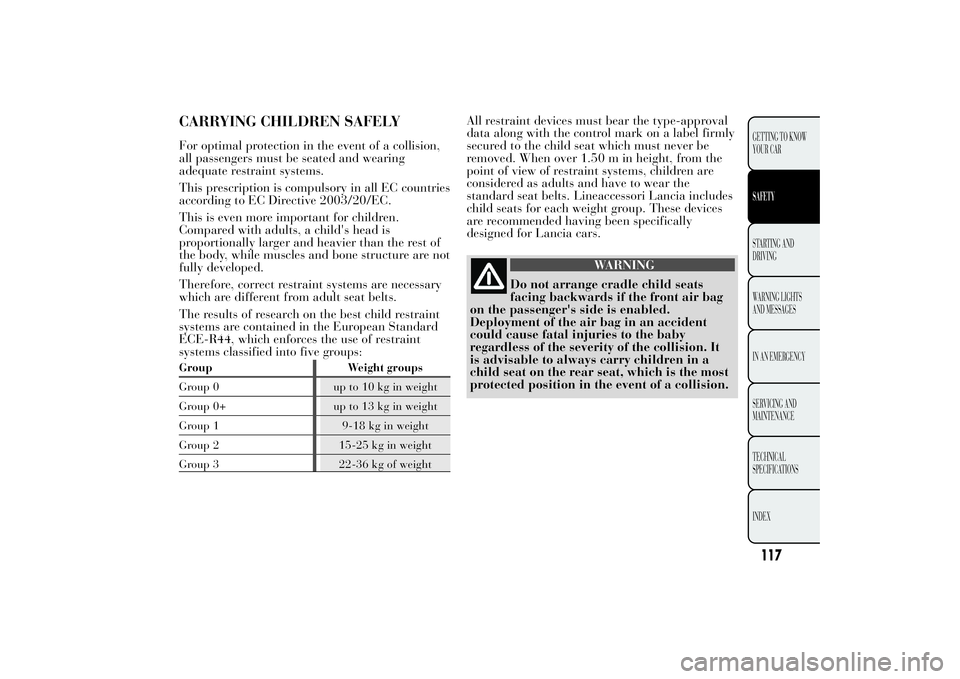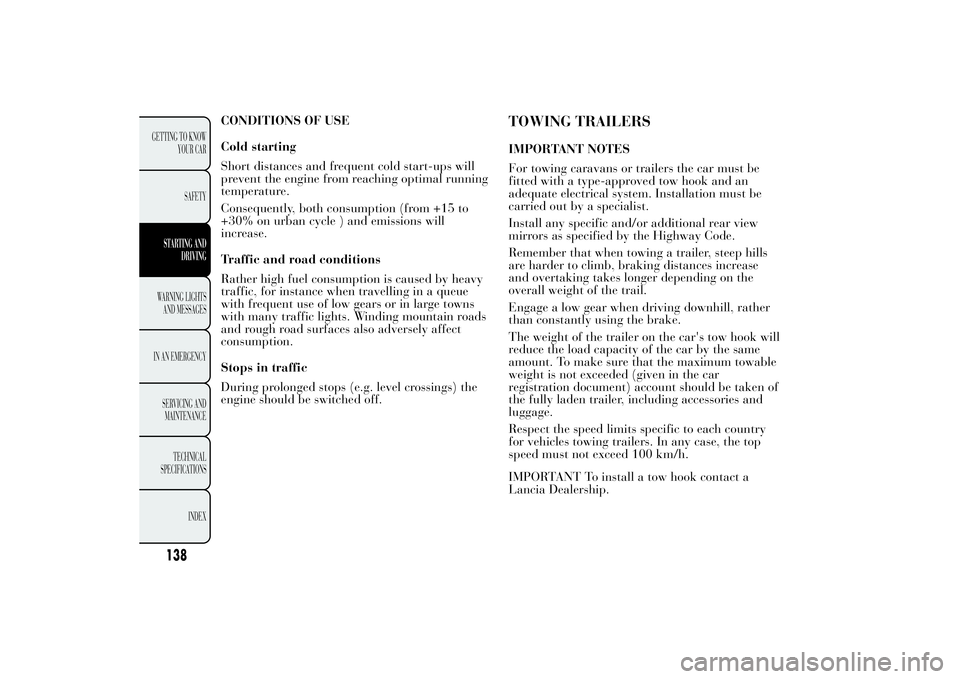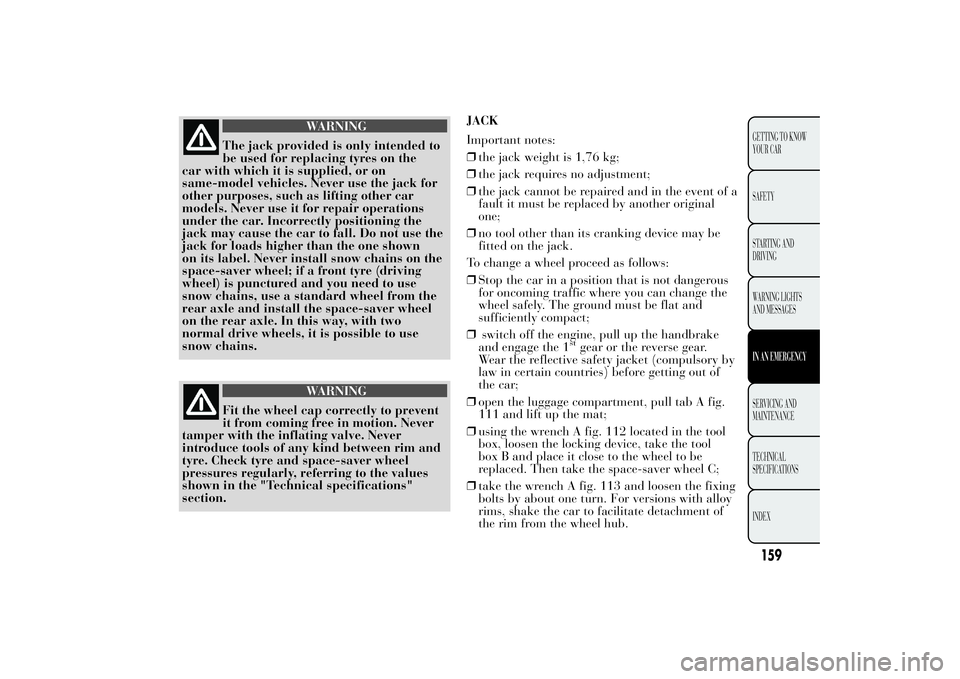weight Lancia Ypsilon 2011 Owner handbook (in English)
[x] Cancel search | Manufacturer: LANCIA, Model Year: 2011, Model line: Ypsilon, Model: Lancia Ypsilon 2011Pages: 299, PDF Size: 13.35 MB
Page 119 of 299

CARRYING CHILDREN SAFELYFor optimal protection in the event of a collision,
all passengers must be seated and wearing
adequate restraint systems.
This prescription is compulsory in all EC countries
according to EC Directive 2003/20/EC.
This is even more important for children.
Compared with adults, a child's head is
proportionally larger and heavier than the rest of
the body, while muscles and bone structure are not
fully developed.
Therefore, correct restraint systems are necessary
which are different from adult seat belts.
The results of research on the best child restraint
systems are contained in the European Standard
ECE-R44, which enforces the use of restraint
systems classified into five groups:Group Weight groups
Group 0 up to 10 kg in weight
Group 0+ up to 13 kg in weight
Group 1 9-18 kg in weight
Group 2 15-25 kg in weight
Group 3 22-36 kg of weight
All restraint devices must bear the type-approval
data along with the control mark on a label firmly
secured to the child seat which must never be
removed. When over 1.50 m in height, from the
point of view of restraint systems, children are
considered as adults and have to wear the
standard seat belts. Lineaccessori Lancia includes
child seats for each weight group. These devices
are recommended having been specifically
designed for Lancia cars.
WARNING
Do not arrange cradle child seats
facing backwards if
the front air bag
on the passenger's side is enabled.
Deployment of the air bag in an accident
could cause fatal injuries to the baby
regardless of the severity of the collision. It
is advisable to always carry children in a
child seat on the rear seat, which is the most
protected position in the event of a collision.
117GETTING TO KNOW
YOUR CARSAFETYSTARTING AND
DRIVING
W
ARNING LIGHTS
ANDMESSAGES
IN AN EMERGENCY
SERVICING AND
MAINTENANCE
TECHNICAL
SPECIFICATIONS
INDEX
Page 121 of 299

GROUP 1
From 9 kg to 18 kg in weight, children may be
carried facing forwards fig. 98.
WARNING
Child seats with Isofix attachment are
available for a
safe anchoring to the
seat without using the car seat belts.
WARNING
The figures are only examples for
fitting purposes. Install
the car seat
according to the instructions, which are
mandatorily included with this type of
restraint system.GROUP 2
Children from 15 to 25 kg may use the car seat
belts directly fig. 99.
The child seat is now needed only to position the
child correctly with respect to the belts so that the
diagonal section crosses the child's chest and
never the neck, and the lower part is snug on the
pelvis not the abdomen.
fig. 98
L0F0187
fig. 99
L0F0014
119GETTING TO KNOW
YOUR CARSAFETYSTARTING AND
DRIVING
W
ARNING LIGHTS
ANDMESSAGES
IN AN EMERGENCY
SERVICING AND
MAINTENANCE
TECHNICAL
SPECIFICATIONS
INDEX
Page 123 of 299

SUITABILITY OF PASSENGER SEATS FOR UNIVERSAL CHILD SEAT USE
The car complies with the new European Directive 2000/3/EC which governs the arrangement
possibilities for child restraints on the various seats of the car as shown in the following table:Group Weight groups Front passenger Rear central passengerRear side
passengers
Group 0, 0+ up to 13 kg
UXU
Group 1 9-18 kg
UXU
Group 2 15-25 kg
UXU
Group 3 22-36 kg
UXU
U= suitable for child restraint systems of the “Universal” category, according to European Standard EEC-R44 for the specified
“Groups”.
X= seat not suitable for children in this weight category.
Main safety rules to be followed when
carrying children:
❒Install the child seats on the rear seat, which is
the most protected position in the event of an
accident.
❒If the passenger's air bag is deactivated always
check the warning light on the instrument
panel to make sure that it has actually been
deactivated.
❒Carefully follow the instructions supplied with
the child seat which are mandatory by law.
Keep the instructions in the car along with the
other documents and this handbook. Do not use
second-hand child seats without instructions.
❒Always check that the seat belt is well fastened
by pulling on it.❒Only one child is to be strapped into each
retaining system; never carry two children using
one child seat.
❒Always check that the seat belts do not restrain
the child's throat.
❒While travelling, do not let the child sit
incorrectly or release the belts.
❒Never carry children on your lap, even
newborns. No-one can restrain a child in the
event of an accident.
❒In the event of an accident, replace the child
seat with a new one.
121GETTING TO KNOW
YOUR CARSAFETYSTARTING AND
DRIVING
W
ARNING LIGHTS
AND MESSAGES
IN AN EMERGENCY
SERVICING AND
MAINTENANCE
TECHNICAL
SPECIFICATIONS
INDEX
Page 124 of 299

ISOFIX CHILD SEAT SETUPThe car can be fitted with a Universal Isofix child
seat, a new European standardised system for
carrying children safely.
Isofix systems can be fitted alongside traditional
child seat. An example of Universal Isofix child
seat covering weight group 1 is shown in fig. 101.
Specific Isofix child seats cover the other weight
groups. These seats must be designed, tested
and type-approved specifically for this car (refer
to the list of cars attached to the child seat).
IMPORTANT The central rear seat is not
approved for any type of Isofix seats
fig. 101
L0F0016
122
GETTING TO KNOW
YOUR CAR
SAFETY
STARTING AND
DRIVING
W
ARNING LIGHTS
ANDMESSAGES
IN AN EMERGENCY
SERVICING AND
MAINTENANCE
TECHNICAL
SPECIFICATIONS
INDEX
Page 126 of 299

SUITABILITY OF PASSENGER SEATS FOR ISOFIX CHILD SEAT USE
The table below shows the different installation possibilities of Isofix restraint systems on seats fitted
with Isofix attachments in compliance with European standard ECE 16.Weight group Child seat position Isofix size class Rear passenger
Portable cradleFacing backwards F
X
Facing backwards G
X
Group 0 up to 10 kg Facing backwards E
IL (*)
Group 0+ up to 13 kgFacing backwards E
IL (*)
Facing backwards D
IL (*)
Facing backwards C
X
Group1from9upto18
kgFacing backwards D
IL (*)
Facing backwards C
X
Facing forwards B
IUF
Facing forwards BI
IUF
Facing forwards A
IUF
X: Isofix position not suitable for child seats in this weight group and/or size class.
IL (*): The Isofix child seat can be installed by adjusting the front seat
IUF: suitable for Isofix restraint systems to be positioned facing forwards, universal class (fitted with third upper mounting),
approved for the relevant weight group.
124
GETTING TO KNOW
YOUR CAR
SAFETY
STARTING AND
DRIVING
W
ARNING LIGHTS
ANDMESSAGES
IN AN EMERGENCY
SERVICING AND
MAINTENANCE
TECHNICAL
SPECIFICATIONS
INDEX
Page 138 of 299

WARNING
Press the clutch pedal fully to change
gears correctly.
It is therefore
essential that there is nothing under the
pedals: make sure the mats are lying flat and
do not get in the way of the pedals.Do not drive with your hand resting on
the gear lever as the force exerted,
even if slight, could lead over time to
premature wear of the gearbox internal
components.
FUEL SAVINGSHere are some suggestions which may help you to
save fuel and lower the amount of harmful
emissions released into the atmosphere.
GENERAL CONSIDERATIONS
Car maintenance
Have checks and adjustments carried out in
accordance with the “Scheduled Servicing Plan”.
Tyres
Check the tyre pressure at least once every 4
weeks: if the pressure is too low, consumption
levels increase as resistance to rolling is higher.
Unnecessary loads
Do not travel with an overloaded boot. The weight
of the car and its arrangement greatly affect fuel
consumption and stability.
Roof rack/ski rack
Remove the roof rack or the ski rack from the roof
after use. These accessories lower aerodynamic
penetration and adversely affect consumption
levels. When transporting particularly large
objects, use a trailer if possible.
136
GETTING TO KNOW
YOUR CAR
SAFETY
STARTING AND
DRIVINGWARNING LIGHTS
AND
MESSAGES
IN AN
EMERGENCY
SERVICING AND
MAINTENANCE
TECHNICAL
SPECIFICATIONS
INDEX
Page 140 of 299

CONDITIONS OF USE
Cold starting
Short distances and frequent cold start-ups will
prevent the engine from reaching optimal running
temperature.
Consequently, both consumption (from +15 to
+30% on urban cycle ) and emissions will
increase.
Traffic and road conditions
Rather high fuel consumption is caused by heavy
traffic, for instance when travelling in a queue
with frequent use of low gears or in large towns
with many traffic lights. Winding mountain roads
and rough road surfaces also adversely affect
consumption.
Stops in traffic
During prolonged stops (e.g. level crossings) the
engine should be switched off.
TOWING TRAILERSIMPORTANT NOTES
For towing caravans or trailers the car must be
fitted with a type-approved tow hook and an
adequate electrical system. Installation must be
carried out by a specialist.
Install any specific and/or additional rear view
mirrors as specified by the Highway Code.
Remember that when towing a trailer, steep hills
are harder to climb, braking distances increase
and overtaking takes longer depending on the
overall weight of the trail.
Engage a low gear when driving downhill, rather
than constantly using the brake.
The weight of the trailer on the car's tow hook will
reduce the load capacity of the car by the same
amount. To make sure that the maximum towable
weight is not exceeded (given in the car
registration document) account should be taken of
the fully laden trailer, including accessories and
luggage.
Respect the speed limits specific to each country
for vehicles towing trailers. In any case, the top
speed must not exceed 100 km/h.
IMPORTANT To install a tow hook contact a
Lancia Dealership.
138
GETTING TO KNOW
YOUR CAR
SAFETY
STARTING AND
DRIVINGWARNING LIGHTS
AND
MESSAGES
IN AN
EMERGENCY
SERVICING AND
MAINTENANCE
TECHNICAL
SPECIFICATIONS
INDEX
Page 161 of 299

WARNING
The jack provided is only intended to
be used for
replacing tyres on the
car with which it is supplied, or on
same-model vehicles. Never use the jack for
other purposes, such as lifting other car
models. Never use it for repair operations
under the car. Incorrectly positioning the
jack may cause the car to fall. Do not use the
jack for loads higher than the one shown
on its label. Never install snow chains on the
space-saver wheel; if a front tyre (driving
wheel) is punctured and you need to use
snow chains, use a standard wheel from the
rear axle and install the space-saver wheel
on the rear axle. In this way, with two
normal drive wheels, it is possible to use
snow chains.
WARNING
Fit the wheel cap correctly to prevent
it from coming
free in motion. Never
tamper with the inflating valve. Never
introduce tools of any kind between rim and
tyre. Check tyre and space-saver wheel
pressures regularly, referring to the values
shown in the "Technical specifications"
section.JACK
Important notes:
❒the jack weight is 1,76 kg;
❒the jack requires no adjustment;
❒the jack cannot be repaired and in the event of a
fault it must be replaced by another original
one;
❒no tool other than its cranking device may be
fitted on the jack.
To change a wheel proceed as follows:
❒Stop the car in a position that is not dangerous
for oncoming traffic where you can change the
wheel safely. The ground must be flat and
sufficiently compact;
❒switch off the engine, pull up the handbrake
and engage the 1
stgear or the reverse gear.
Wear the reflective safety jacket (compulsory by
law in certain countries) before getting out of
the car;
❒open the luggage compartment, pull tab A fig.
111 and lift up the mat;
❒using the wrench A fig. 112 located in the tool
box, loosen the locking device, take the tool
box B and place it close to the wheel to be
replaced. Then take the space-saver wheel C;
❒take the wrench A fig. 113 and loosen the fixing
bolts by about one turn. For versions with alloy
rims, shake the car to facilitate detachment of
the rim from the wheel hub.
159GETTING TO KNOW
YOUR CAR
SAFETY
STARTING AND
DRIVING
WARNING LIGHTS
AND MESSAGESIN AN EMERGENCYSERVICING AND
MAINTENANCE
TECHNICAL
SPECIFICA
TIONS
INDEX
Page 222 of 299

TECHNICAL SPECIFICATIONS
IDENTIFICATION DATAWe recommend taking note of the identification
codes. The following identification codes are
printed and shown on the plates:
❒VIN plate.
❒Chassis marking.
❒Bodywork paint identification plate.
❒Engine marking.V.I.N. PLATE
This is applied on the left side of the luggage
compartment fig. 167 (lift the mat for access) and
bears the following data:
BType-approval number.CVehicle type identification code.D
Chassis serial number.
EMaximum authorised weight of vehicle fully
laden.FMaximum authorised weight of vehicle fully
laden plus trailer.G
Maximum authorised weight on first (front)
axle.
H
Maximum authorised weight on second (rear)
axle.
IEngine type.LBodywork version code.M
Number for spare parts.
N
Correct value of smoke coefficient (for diesel
engines).
fig. 167
L0F0029
220
GETTING TO KNOW
YOUR CAR
SAFETY
STARTING AND
DRIVING
WARNING LIGHTS
AND MESSAGES
IN AN EMERGENCY
SERVICING AND
MAINTENANCE
TECHNICAL
SPECIFICA
TIONS
INDEX
Page 237 of 299

WEIGHTS AND LOADSVersions 0.9 TwinAir 85 HP 1.2 8V 69 HP 1.3 16V MultiJet
Unladen weight (with all fluids, fuel
tank filled to 90% and without
optional equipment) (kg):975 965 1050
Payload including the driver (kg):(*)
480 (4-seater) / 535
(5-seater)480 (4-seater) / 535
(5-seater)480 (4-seater) / 535
(5-seater)
Maximum permitted loads (kg)
(**)
800 870 – front axle:
– rear axle: 810 810 810
– total:1455 (4-seater) / 1510
(5-seater)1445 (4-seater) / 1500
(5-seater)1530 (4-seater) / 1585
(5-seater)
Towable loads (kg)
750 750 – braked trailer:
– non-braked trailer: 400 400 400
Maximum load on roof: 55 55 55
Maximum load on the tow hook
(braked trailer) (kg):60 60 60
(*) If special equipment is fitted (sunroof, tow hitch, etc.) the unladen car weight increases, thus reducing the specified payload
with respect to the maximum permitted load.
(**) Loads not to be exceeded. The user is responsible for arranging goods in the luggage compartment and/or load carrying
platform within the maximum permitted loads.
235GETTING TO KNOW
YOUR CAR
SAFETY
STARTING AND
DRIVING
WARNING LIGHTS
AND MESSAGES
IN AN EMERGENCY
SERVICING AND
MAINTENANCETECHNICAL
SPECIFICA
TIONSINDEX
780
1000